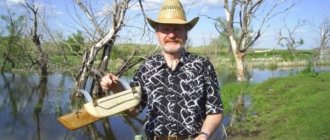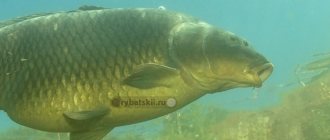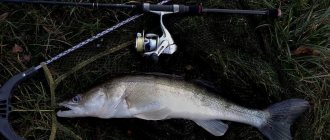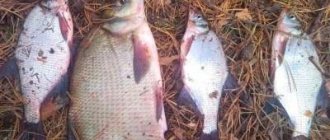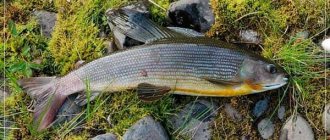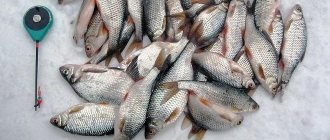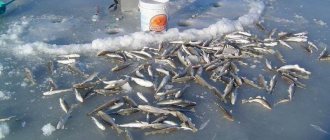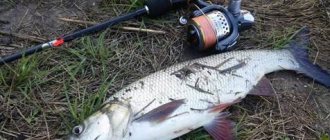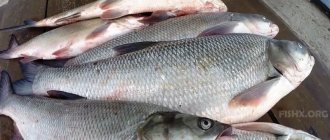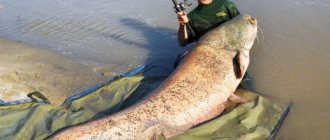Catching gudgeon in winter is not such an easy task when compared with catching gudgeon in the warm season. But if you know where to look for it, and also how and what to catch it with. And they catch gudgeon in winter mainly because it is a very good live bait for catching predatory fish and will be an excellent bait when fishing with gudgeons or any other winter live bait gear. The gudgeon is a universal live bait that is suitable for catching fish such as:
- pike;
- zander;
- burbot;
- ide;
- chub.
Therefore, many fishermen in winter want to get gudgeon as live bait. Some people don’t even know that this fish can be caught in winter.
Tackle and bait for catching gudgeon in winter
To catch gudgeon, the thinnest gear is used, because this fish is not large and the use of coarse equipment will lead to a significant reduction in the number of gudgeon bites or their complete absence. Therefore, to catch gudgeon in winter, it is best to get a separate winter fishing rod, which will be designed specifically for catching small fish such as gudgeon.
To catch gudgeon in winter, you should use a jig weighing approximately 0.2 grams and a fishing line with a cross-section of 0.06-0.07 mm. The use of such gear will make winter gudgeon fishing as productive as possible. It is also very important that the hook of the jig be small and thin. A hook No. 18-20 is best suited. Place bloodworms on the hook of the jig. On a thin and small hook, the bloodworm will hold very well and remain active for a long time and very attractive to the gudgeon.
Although gudgeon can be quite successfully caught in winter using a jig without a bait or other bait, it is still best to catch gudgeon when using bloodworms as bait. And since the gudgeon is a small fish, when catching it with a winter fishing rod, it is necessary to use a sensitive nod. Usually, a gudgeon bite in winter looks like a sharp lowering of the nod down, as if it presses the jig to the bottom. Such bites most often end in a successful hook. So let's sum it up,
what tackle and bait is most suitable for winter gudgeon fishing:
- Mormyshka - 0.2 grams;
- Fishing line - 0.06-0.07 mm;
- Hook - No. 18-20 made of thin wire.
- The nod is the most sensitive;
- The bait is bloodworm.
Groundbait and bait
Fishing for gudgeons in winter can be done either with or without bait. The most commonly used and popular bait is the common bloodworm. It should be frozen first and thrown into the hole in small pieces. In this case, the bloodworms will slowly thaw in cold water and gradually disintegrate, spreading the smell and attracting fish.
They also use various purchased or independently prepared vegetable mixtures of fine fractions, but bloodworms are considered a more suitable bait. Simply sprinkle the plant mixture onto the surface of the water in the hole - the swollen small particles will gradually sink to the bottom, luring the fish.
The small gudgeon gets full very quickly, which causes certain difficulties. It is easy to overfeed even with small bloodworms, so many anglers prefer not to use bait at all.
Bloodworms are best suited as bait - the gudgeon prefers it to all other baits. You can catch gudgeon with an empty jig, but with a bait of bloodworms the result will be much better.
The larvae should be planted one at a time, or less often two. To avoid constant replacement of the nozzle with each bite, bloodworm larvae should be baited in a ring.
Where to catch gudgeon in winter
If you caught gudgeon in open water in summer or spring, then it will not be difficult for you to determine a place that will be promising for catching it in winter. Well, as you know, the gudgeon lives in rivers or artificially created ponds with the help of dams on small rivers. But it is much more difficult to find a gudgeon on a river than in ponds. And the gudgeon from the pond behaves much more actively on the hook when it is used as bait for a predator, constantly trying to go to the bottom.
Typically, the gudgeon prefers places close to the shore and rarely goes to a depth of more than 2-3 meters. In winter, it tries to stay in small depressions with a sandy or silty-sandy bottom. Loves areas where there are various obstacles in the water, in the form of stones, trees, etc. If fishing takes place on a river, then the gudgeon hides behind such barriers from the current, so the bait must be thrown a little downstream from the barrier or directly under it.
In general, a variety of bait attracts gudgeons very well. As bait for gudgeon in winter, you can use either various cereals, or simply throw a small amount of bloodworms into the hole.
A little bit of bait is enough for a minnow. The gudgeon is a small fish, for which a pinch of bloodworm is enough for the entire school to circle around the place where it was caught for half an hour. It is important not to overfeed this small fish, otherwise it will simply get full and the bite will stop.
Minnow fishing in February
February is favorable for catching gudgeon due to the fact that at this time the first thaw often occurs, which drives the fish out of their muddy shelters. The gudgeon rises to the very surface and basks in the rays of the sun penetrating under the water. At night there is practically no bite, the gudgeon sleeps. Therefore, you need to catch it from sunset to sunrise.
In February, any supplement will be suitable for catching this fish. Moreover, you don’t need much of it at all, since the size of the gudgeon is not large. You should not overdo it with complementary foods, because the fish can go back to its rookery after eating. For example, a small amount of bloodworm mixed with porridge and bread is suitable. As a result of such feeding, a whole flock of minnows will frolic near the hole. Bloodworms are also suitable as bait, or you can fish with a worm. Read also: Spring gudgeon fishing
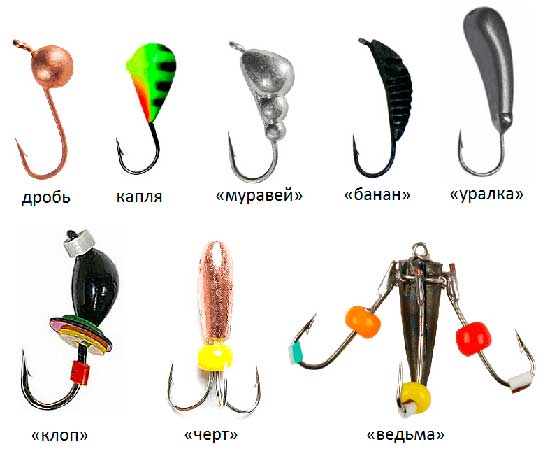
The shape of jigs is not particularly important for catching minnows; fish take well on any of them. Color is also not important. The fishing line should not be thick, especially since there is no point in it, because the weight of the prey will be small in any case.
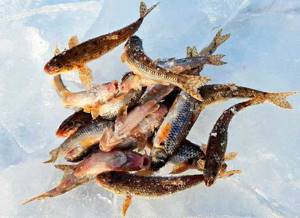
It should be noted that the gudgeon’s biting area is quite local, so you should carefully choose the place where the hole will be drilled. If, despite active baiting, there is no bite in this place, it would be better to make a hole in another place.
The gudgeon is a schooling fish, so even from one hole you can pull out a lot of these small fish. By the way, the larger the reservoir, the larger the size the gudgeon can reach.
In general, we can say that February is an excellent month for catching live bait, in particular gudgeon. This month, catching small fish will not be difficult.
How to catch gudgeon in winter. Fishing technique
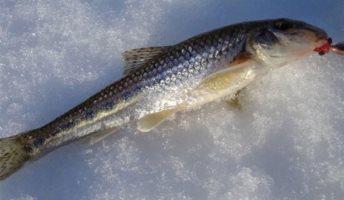
The technique for catching gudgeon in winter is not complicated and depends on the degree of activity of the gudgeon. Usually, gudgeons are excellently caught all winter in any weather, only occasionally, they stop biting on some days, regardless of the weather.
If the gudgeon bite is active, you can catch it by placing the bait stationary right above the very bottom. If the gudgeon is a little capricious, then you should use active fishing with bait. There are several ways to play minnow this way:
- The bait is played at the very bottom with light and smooth swaying of the nod. The game is played without lifting and creates the illusion of the bloodworm moving with periodic blows to the bottom. Playing sharply with bait will only scare away the gudgeon, so you need to make very light and smooth movements.
- The same smooth and slow game with swinging the bait only with a slow rise of 10-15 cm from the bottom. The rise of the bait should be slow, because the gudgeon will not chase quickly moving prey.
Open water fishing
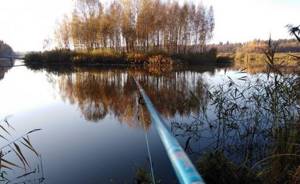
In general, gudgeon fishing begins almost immediately after the ice melts. As the water warms up, the bite becomes more confident, intensifying until the start of a long spawning season. On average, the spawning time of minnows falls in April - May, and can last up to two months. At this time, the fish move into shallow water in schools. This is where she should be guarded.
In spring, gudgeon bite all day, starting from the very early morning and ending late in the evening. In summer, during hot hours, on the contrary, there is practically no bite. At night, the gudgeon is not active; it descends closer to the bottom and does not rise until dawn. In the morning hours, the entire flock is still at the bottom, but only after noticing the prey does the fight begin. Each minnow tries to grab it first. Therefore, in the morning hours, the fisherman will not have to wait long for the first bites.
Recommended reading: Baikal grayling
The fish actively bite after rains, when muddy water from the banks rushes into the rivers. Such streams carry a lot of food with them. Thanks to the sensitivity of its antennae, it is not difficult for it to find prey in muddy water.
Fishing in summer
The tactics for catching gudgeons in the summer are simple: having chosen a place (most often in shallow water with a moderate current, a sandy or rocky bottom), the fisherman sets the depth so that the hook goes to the very bottom, casts upstream, the current carries the tackle, and at this time a bite occurs (in the wiring). It’s simple, the main thing is that the tackle goes along the bottom.
Often, a bite is even determined not visually by the float, but by a light blow to the hand. In our practice, we set the line to 0.15 mm, so everything is felt very well. It is better not to plant a whole worm, since the gudgeon will not take the whole worm, but will only tug at it. A piece is enough. Having pulled out the minnow, they make the next cast - from one place you can catch more than a dozen fish.
Sometimes they fish from the shore, sometimes they go knee-deep into the river and fish in this format. In this case, the gudgeon can literally approach the fisherman’s feet, focusing on the mud that comes from the fisherman.
Minnow trap

Almost any mixture edible for fish is suitable for bait. There is another way to catch minnows. It does not injure the fish and is very simple, so it should be disassembled separately from the rest. You should take a container, for example, a three-liter jar, plastic bottle, pan, basin or something similar will do. The container is buried in the sand, leaving a hole with a diameter of 10-15 centimeters.
For example, if you use a basin, then cover the top with a cloth and cut a hole 10-15 cm in diameter on the surface. You can put worms or bloodworms at the bottom to attract inquisitive fish. The fish willingly swims into this container, and the fisherman only has to get the “minnow in the house.” This fishing method is often used by very young beginner fishermen.
We recommend reading: Winter fishing for bream
Minnows are very inquisitive and somewhat fearless, so catching them is not difficult. No special equipment or preparation is needed to catch them. There is an opportunity to show off your catch almost all year round. Minnows can be delicious cooked or used as bait for larger fish. This is why they are valued by both beginners and experienced fishermen.
Selecting a location
The very name of this fish suggests that it prefers sandy places. The way it is. In the summer, on sandy rifts you can see huge schools of these fish, which stay at a depth of no more than half a meter and desperately bite on a float rod with a small float, thin fishing line and a piece of a worm on a swallow hook. You can catch hundreds of minnows in such places, but there is no such need. Larger minnows also stay on the sand, but next to thickets of grass.
In winter, these fish leave the rifts, although sometimes they bite in the pits under the rifts. But more often they can be found at the middle depth of pools with a sandy bottom behind a strip of coastal grass, which is still visible from the first ice. Also, schools of minnows stay at the mouths of streams and rivers, of course, where the bottom is sandy.
These fish prefer places with current, but not very strong. Typically, minnows stay on the boundary between the core stream and the reverse current. In winter you should look for this fish here.
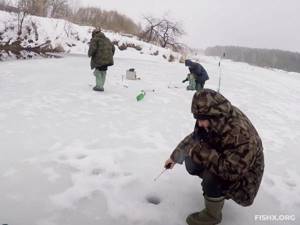
A gudgeon on the lake
A completely different type of fishing occurs in reservoirs without a current, for example, on the same river, but in a dam above the dam. However, it is better to look not for dams on the “minnow” river, but for deep spring reservoirs with noticeable water flow. There are lakes into which no rivers flow, but only one, as a rule, flows out. It is in such reservoirs that the gudgeon reaches a record size. Apparently, the reason is a very good food supply of caddis flies and worms. In spring lakes, especially those with a large area, it is difficult to look for gudgeon, since this fish migrates little and even reacts to bloodworm bait only if it is in close proximity. The search is also complicated by the fact that without activating the fish with bait, bites are very rare. But if a fish site is discovered, you can fish on it all winter. It is better to find several sites, as it happens that there is a bite in one, but not in another.
News: Winter search for burbot on lakes and reservoirs
It makes sense to look for gudgeon winter sites close to the places where it stays in the summer. These are the mouths of inflowing streams and areas near dams and pits. If the depth of the summer mooring exceeds 2 m, then the gudgeon will almost certainly be there in the winter. Actually, having discovered summer deep sites, we can assume that winter ones have also been found, since the gudgeon is not prone to seasonal migrations. This is one of the fundamental differences in the behavior of the gudgeon in the current and in calm water.
You can almost always find parking on a flat table between two edges, and its width can be no more than 1 m. It is more of a step than a table. If the bottom has ledges, then the gudgeon can stay both on the deepest and on the central step, and very rarely on the one that is closer to the shore. Fish can also be found here, but not in winter.
Fishing begins with preparing at least seven or eight holes above the parking area, drilling them every 1.5 m. By the way, there may not be bites in the “old” holes. The fish still migrates, but at the same time adheres to the same depth and within ten meters. It seems that the gudgeon methodically walks around the same areas during the winter. The bite in a particular hole can be affected by the weather. In sunny weather, the gudgeon prefers shallower areas; and its bite turns out to be more stable and lasting. Perhaps the fact that the peak bite usually occurs at 10–11 am and at 2–3 pm is also related to the illumination. On sunny days there may not be an evening bite, but the morning bite is very active.

